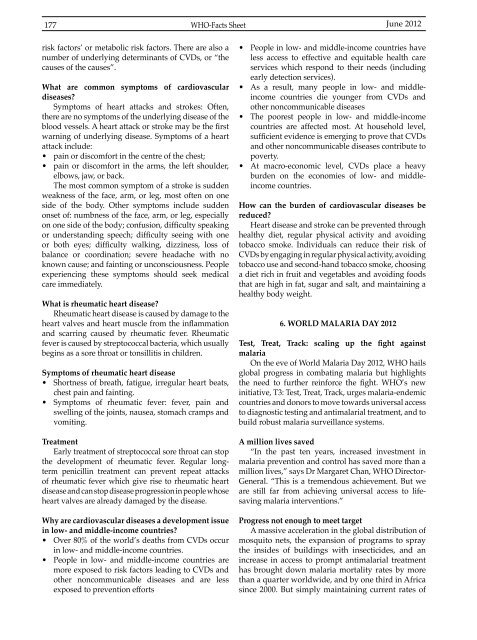Vol 44 # 2 June 2012 - Kma.org.kw
Vol 44 # 2 June 2012 - Kma.org.kw
Vol 44 # 2 June 2012 - Kma.org.kw
You also want an ePaper? Increase the reach of your titles
YUMPU automatically turns print PDFs into web optimized ePapers that Google loves.
177<br />
WHO-Facts Sheet <strong>June</strong> <strong>2012</strong><br />
risk factors’ or metabolic risk factors. There are also a<br />
number of underlying determinants of CVDs, or “the<br />
causes of the causes”.<br />
What are common symptoms of cardiovascular<br />
diseases?<br />
Symptoms of heart attacks and strokes: Often,<br />
there are no symptoms of the underlying disease of the<br />
blood vessels. A heart attack or stroke may be the first<br />
warning of underlying disease. Symptoms of a heart<br />
attack include:<br />
• pain or discomfort in the centre of the chest;<br />
• pain or discomfort in the arms, the left shoulder,<br />
elbows, jaw, or back.<br />
The most common symptom of a stroke is sudden<br />
weakness of the face, arm, or leg, most often on one<br />
side of the body. Other symptoms include sudden<br />
onset of: numbness of the face, arm, or leg, especially<br />
on one side of the body; confusion, difficulty speaking<br />
or understanding speech; difficulty seeing with one<br />
or both eyes; difficulty walking, dizziness, loss of<br />
balance or coordination; severe headache with no<br />
known cause; and fainting or unconsciousness. People<br />
experiencing these symptoms should seek medical<br />
care immediately.<br />
What is rheumatic heart disease?<br />
Rheumatic heart disease is caused by damage to the<br />
heart valves and heart muscle from the inflammation<br />
and scarring caused by rheumatic fever. Rheumatic<br />
fever is caused by streptococcal bacteria, which usually<br />
begins as a sore throat or tonsillitis in children.<br />
Symptoms of rheumatic heart disease<br />
• Shortness of breath, fatigue, irregular heart beats,<br />
chest pain and fainting.<br />
• Symptoms of rheumatic fever: fever, pain and<br />
swelling of the joints, nausea, stomach cramps and<br />
vomiting.<br />
Treatment<br />
Early treatment of streptococcal sore throat can stop<br />
the development of rheumatic fever. Regular longterm<br />
penicillin treatment can prevent repeat attacks<br />
of rheumatic fever which give rise to rheumatic heart<br />
disease and can stop disease progression in people whose<br />
heart valves are already damaged by the disease.<br />
Why are cardiovascular diseases a development issue<br />
in low- and middle-income countries?<br />
• Over 80% of the world’s deaths from CVDs occur<br />
in low- and middle-income countries.<br />
• People in low- and middle-income countries are<br />
more exposed to risk factors leading to CVDs and<br />
other noncommunicable diseases and are less<br />
exposed to prevention efforts<br />
• People in low- and middle-income countries have<br />
less access to effective and equitable health care<br />
services which respond to their needs (including<br />
early detection services).<br />
• As a result, many people in low- and middleincome<br />
countries die younger from CVDs and<br />
other noncommunicable diseases<br />
• The poorest people in low- and middle-income<br />
countries are affected most. At household level,<br />
sufficient evidence is emerging to prove that CVDs<br />
and other noncommunicable diseases contribute to<br />
poverty.<br />
• At macro-economic level, CVDs place a heavy<br />
burden on the economies of low- and middleincome<br />
countries.<br />
How can the burden of cardiovascular diseases be<br />
reduced?<br />
Heart disease and stroke can be prevented through<br />
healthy diet, regular physical activity and avoiding<br />
tobacco smoke. Individuals can reduce their risk of<br />
CVDs by engaging in regular physical activity, avoiding<br />
tobacco use and second-hand tobacco smoke, choosing<br />
a diet rich in fruit and vegetables and avoiding foods<br />
that are high in fat, sugar and salt, and maintaining a<br />
healthy body weight.<br />
6. WORLD MALARIA DAY <strong>2012</strong><br />
Test, Treat, Track: scaling up the fight against<br />
malaria<br />
On the eve of World Malaria Day <strong>2012</strong>, WHO hails<br />
global progress in combating malaria but highlights<br />
the need to further reinforce the fight. WHO’s new<br />
initiative, T3: Test, Treat, Track, urges malaria-endemic<br />
countries and donors to move towards universal access<br />
to diagnostic testing and antimalarial treatment, and to<br />
build robust malaria surveillance systems.<br />
A million lives saved<br />
“In the past ten years, increased investment in<br />
malaria prevention and control has saved more than a<br />
million lives,” says Dr Margaret Chan, WHO Director-<br />
General. “This is a tremendous achievement. But we<br />
are still far from achieving universal access to lifesaving<br />
malaria interventions.”<br />
Progress not enough to meet target<br />
A massive acceleration in the global distribution of<br />
mosquito nets, the expansion of programs to spray<br />
the insides of buildings with insecticides, and an<br />
increase in access to prompt antimalarial treatment<br />
has brought down malaria mortality rates by more<br />
than a quarter worldwide, and by one third in Africa<br />
since 2000. But simply maintaining current rates of
















